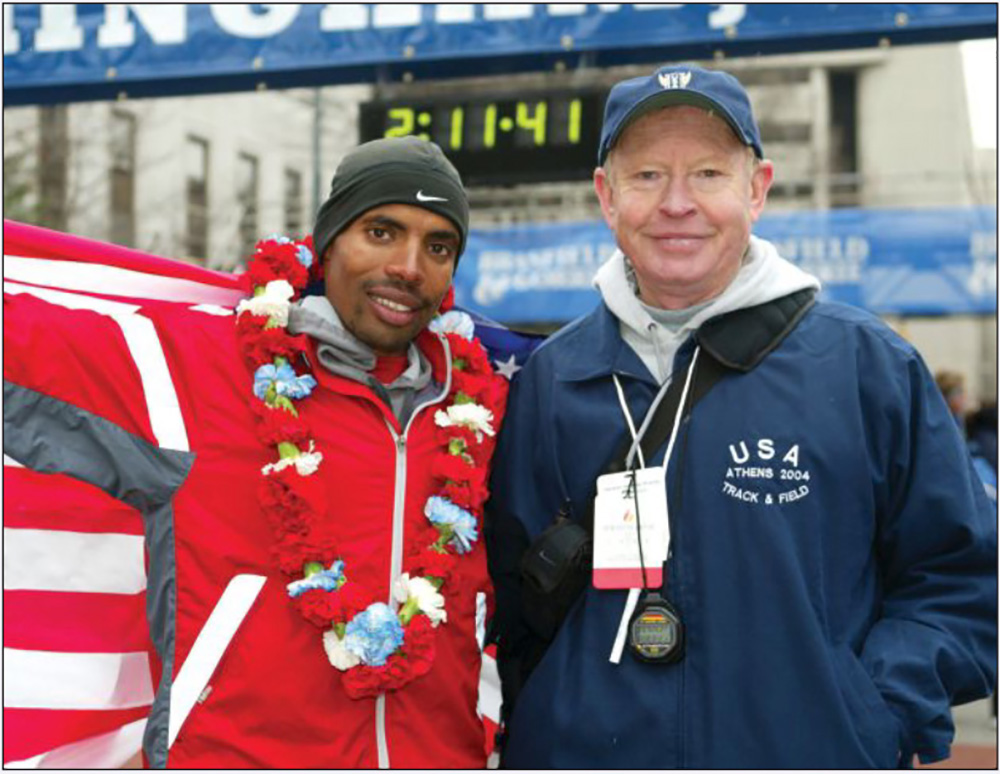
(from the April 2014 issue of T&FN)
TRAINING GROUPS, enclaves — whatever your preferred term — have turned the U.S. distance running tide since this century began. After no American runner above 400 scored a top 6 Olympic finish in Sydney, Deena Kastor and Meb Keflezighi carried the first surge onto the beach in ‘04 as they took marathon medals in Athens.
What lifted their careers was the Mammoth Track Club — guided in its early years by Bob Larsen and Joe Vigil.
Meb and Deena, says Larsen, who recently was inducted into USATF’s Hall of Fame, “are kind of the face of what we were able to accomplish, particularly in getting Americans to go to altitude, which we always thought we really needed to do if we were going to become competitive internationally.
“They were the ones that by being willing to do that and getting the medals in 2004 spurred others to do the same thing.”
While a handful of U.S. athletes with Colorado-based coaches prepared for the ‘00 Games at elevation, only one runner above 800 on the London ‘12 team didn’t employ altitude training (or in the case of Princeton steepler Donn Cabral sleep in an altitude tent).
Since Keflezighi and Kastor broke the dam, Americans at 800 and up have grabbed 16 OG/WC podium spots — plus a trio of 4th-place finishes including Keflezighi’s in the ‘12 Olympic 26-miler. Last year no fewer than 12 U.S. runners World Ranked in those events.
The Mammoth TC, indeed, broke new ground, starting in ‘01. “There was a need for a training group that would go back to some of the things we were doing in the ‘70s and ‘80s, which both Joe and I believed in, and in addition add the altitude component,” says Larsen.
“I suggested Mammoth Lakes and took Joe up there and talked to Dave McCoy, who developed [the ski resort]. He was very positive and encouraging that we do locate our high-altitude training up there.”
Besides Keflezighi and Kastor, Abdi Abdirahman, Matt Downin, Terrence Mahon (later the group’s coach), James Menon, Phil Price, Elva Dryer, Milena Glusac, Jen Rhines and Amy Rudolph joined the new enclave in the Sierra Nevadas.
Fortuitously, science had just aggregated some helpful knowledge. At USATF’s Annual Meeting in ‘99, exercise scientists Ben Levine and Robert Chapman presented new research identifying altitude’s sweet spot.
“I think most of us thought that the higher we went at altitude the better results we would get,” Larsen says. “They found that if you went much above 8000ft you would gain some things but you were also losing some of the benefit. So 7–8000ft — the altitude of the Rift Valley where those great distance runners come from — is about the same elevation as Mammoth Lakes, the same elevation as Flagstaff and Park City.
So if you connect the dots, you can see that 8000ft is about ideal, and we did have the place: Mammoth Lakes, 400 miles north of San Diego, 300 miles north of Los Angeles.”
Another advantage of Mammoth, says Larsen, “was that in less than 50 minutes we could actually be down at about 4000ft.” That “helped to be able to go to races closer to race day.
“When you go for a run when you first come down from altitude, you’re breathing quicker, taking more breaths than you really need, and it takes some time to adjust. But by going to the lower elevation and then going down at the last minute to race, it helps. But each individual is different so you try to tune it up for them and another factor is how many time zones you have to travel.”
Before Athens, after a 3-week altitude bloc following the track Trials, the Mammoth TCers decamped to Crete for 3 weeks of ac- climatization to Greece’s heat and humidity.
“A lot of people that saw Meb and Deena at the end [of the ‘04 Olympic marathons] thought they were as fit as maybe anybody there, Larsen recalls. “Meb didn’t cover that last move by [gold medalist Stefano] Baldini. [He figured] that with the World Record holder, Tergat, behind him, and he’d be taking the silver medal when an American hadn’t got a medal in 28 years, he probably shouldn’t chance it.
“But when he finished he was jogging around and high-fiving people. Baldini was on the ground and couldn’t get up.
“Deena was the same. She looked great. Part of it was the pacing and all that, but using altitude and then being ready for heat and high humidity — getting that mixture right — showed that in races in extreme conditions planning gives people an opportunity to maybe do a little bit more.”